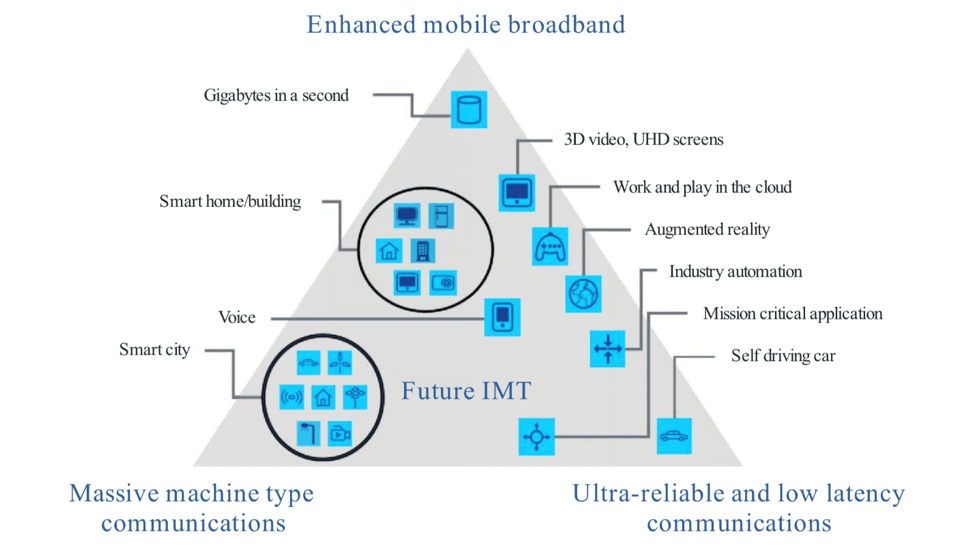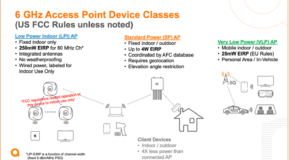Last time we looked at the 5G network architecture and, specifically, at the role it creates for enterprise Wi-Fi as a 5G radio access technology. But 5G is more than just a technical specification. Understanding 5G and what it means for enterprise networks will also mean coming to terms with an evolving dynamic of aspirational use cases, physical limitations, commercial pressures, and market expectations.
A Framework for Understanding 5G Use Cases
Back in 2012, the International Telecommunications Union (ITU) began to consider three broad areas where existing cellular networks needed improvement. The proposals they formulated to address these shortcomings identified Enhanced Mobile Broadband (eMBB), Ultra Reliable Low Latency Communication (URLLC), such as industry automation, and Massive Machine Type Communication (mMTC), such as smart homes, as critical dimensions within which to capture emerging use cases.

Figure Source: ITU-R M-2083-0, “IMT Vision – Framework and overall objectives of the future development of IMT for 2020 and beyond” (September, 2015).
Consumers had gotten a taste of the mobile internet and their appetite for data was exploding. But user experience frequently fell short in comparison to Wi-Fi or home broadband connections and cellular networks lacked the capacity to satisfy demand. Within the enterprise, new use cases were emerging – from precision manufacturing to robotic surgery – that attracted the attention of mobile network operators but would require levels of reliability and determinism beyond the data-handling capability of their centrally-managed cellular networks. And a proliferation of low cost, low power sensors were generating a flood of new data, an Internet of Things (IoT), promising rapid growth of client devices in a market otherwise saturated with subscribers, but at densities and with cost and power limits that would strain a framework designed to service handheld mobile phones.
This analysis was eventually consolidated into performance requirements and adopted by 3GPP as a roadmap for 5G, with eMBB driving overall capacity and throughput, URLLC driving latency and reliability, and the mMTC driving scalability targets. This framework is a useful way to understand 5G insofar as it highlights the need to overcome specific limitations of a previous generation of cellular networks, but it does not yet get to the bottom of why the 5G vision became so important to mobile network operators or how its realization would affect the enterprise network.
A Framework for Understanding Operator Strategy
Mobile networks operators face three major challenges that motivate their approach to 5G.
First, they must find a way to increase capacity without increasing costs. While consumer consumption of mobile data is growing at breakneck speed, their appetite to pay for it is not. Recent studies reveal a clear unwillingness to pay any premium for 5G services. This challenge drives initiatives to improve efficiency in the way 5G radio networks are deployed and to virtualize functions of the 5G core network.
The second operator challenge is to maintain subscriber visibility. Subscribers are increasingly self-selecting Wi-Fi for the vast majority of their mobile data. Inside the buildings where many of us spend most of our time, 4G cellular reception is already a challenge. Trends towards more energy-efficient buildings and the physical characteristics of 5G networks operating at higher frequencies and requiring higher signal-to-noise ratios will only exacerbate this problem over time. Unless operators can address subscriber visibility, their opportunities to develop new services based, for example, on data analytics, or offer any service at all will be greatly diminished. This challenge drives both the push for indoor 5G small cells and consideration of Wi-Fi as a 5G access technology.
Which leads us to the third major challenge: To identify new opportunities for growth in adjacent markets with services that bring value beyond simply widening the dumb data pipe. Initiatives to displace Wi-Fi with managed cellular enterprise networks, to build an IoT ecosystem specific to 5G access, and to challenge cable operators with wireless backhaul are central to the operator 5G strategy.
In a future installment, we will consider how key technology components of 5G are being developed to address each of these strategic challenges. We will look specifically at the 5G New Radio (NR), 5G Next Generation Core (NGC), Multi-Access Edge Computing (MEC), and Fixed Wireless Access (FWA) in terms of the problems they solve and opportunities they open for network operators as well as their implications for enterprise networks.




